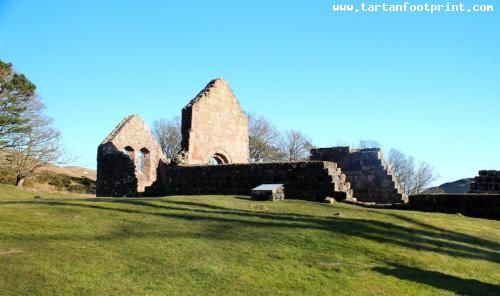You seem to be using an older version of Internet Explorer. This site requires Internet Explorer 8 or higher. Update your browser here today to fully enjoy all the marvels of this site.
This is from Canmore's Site Record: St Blane's Church and Monastery (S Cruden 1960): St Blane's Monastery was built at an unknown date prior to 574. There is clear evidence of Christian burial there i...This is from Canmore's Site Record: St Blane's Church and Monastery (S Cruden 1960): St Blane's Monastery was built at an unknown date prior to 574. There is clear evidence of Christian burial there in the 6th and 7th centuries, also that the monastery became a cultural centre around that time. Its list of abbots extends to 790, when the Viking raids began.
St Blane's Church, in use as the parish church of Kingarth until the early 18th century is a fine 12th century Romanesque building consisting of a nave and chancel; the E end of the chancel appears to be of inferior masonry and may be a later rebuild, and the nave was extended to the W in the 15th century. The partly restored walls stand to eaves level, on what was probably a natural eminence, artificially made up to provide a more level surface for the cemetery, which is in two parts. The lower part is traditionally known as the women's burial ground. Within it is a small oblong building, oriented E-W which could have been a Celtic oratory. Extensive excavations by the Marquess of Bute in the late 19th century revealed a wall, apparently dry-built, some 3-4ft wide, now standing 2-3ft high, enclosing an area of 2 or 3 acres. In good condition, it was repaired in 1896.
Traces of further walls running out to the N may not be early. The church and graveyards stood near the centre of the enclosed area. Below the churchyard and still within the enclosure much-ruined irregular lines of stones suggest groups of cells like those found at Tintagel. There are further traces of buildings above the churchyard at the foot of the western outcrop.
Both graveyards are filled with lines of graves marked by cover-stones, mostly of 12th-13th century date. Others may be early, as are some of the stones found during the excavations; they date to the 8th or even 7th century. Excavations at NS 095 534, immediately outside the cashel wall, revealed a corn kiln; 12th-13th century pottery was found (I D Milligan 1963). Much of what is now visible dates from the re-Christianisation of Bute during the period of Norse rule, probably in the 11th century, but some of the sculptures and possibly the enclosure wall and parts of the ruined buildings should be ascribed to the pre-Norse period (C A R Radford 1967).
E W MacKie 1975; J K Hewison 1893; I S Munro 1973; W J Watson 1926;
C Thomas 1971; J Anderson 1900
Centred NS 0942 5353. St Blane's Church (name verified) and monastic settlement occupies a level site which is tucked away in the hills above Dunagoil farm. The occupation area of two hectares is bounded on the W by a near vertical 70ft high rock face and enclosed on the other sides by a restored cashel wall fromw hich another wall (now traceable merely as footings) branches off to enclose a further 0.5 hectares of level ground. The relationship of these two walls cannot now be ascertained. The ruined church and its two graveyards are as described. The walling of the Celtic cell (published as The Nunnery on OS 25") in the lower graveyard is up to 0.6m high and nearby are two gravestones with incised cross designs, and a flat topped earthfast socket stone 0.9m in diameter with a socket 0.4m by 0.1m.
The remains of excavated buildings with walling up to 0.5m high lie to the SW and NW of the church; those to the SW (Ancient Dwellings on OS 25") are almost certainly cells while the latter, two rectangular structures 7.0m by 6.0m and 7.0m by 5.0m are of unknown date and purpose. A crude stone basin, possibly a font, rests near the well (NS05SE 9).
Two circular 'platforms' which are 0.2m high, 6.0m in diameter and probably represent the footings of small buildings are the only traceable features within the outer enclosure wall. The origin of these features however is uncertain. The excavated corn drying kiln is now only recognisable as a 4.0m diameter, 0.2m high bank and lies just outside the main entrance in the cashel wall at NS 0950 5351.
The finds from this site are in Rothesay Museum.
In this photo:


